
Standing NATO Mine Countermeasures Group 1 (SNMCMG1) is a North Atlantic Treaty Organisation (NATO) standing mine countermeasures immediate reaction force. Its role is to provide NATO with an immediate operational response capability.
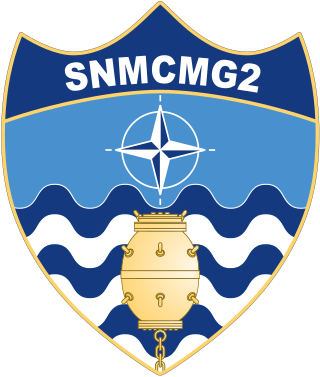
Standing NATO Mine Countermeasures Group 2 (SNMCMG2) is a North Atlantic Treaty Organization (NATO) standing mine countermeasures Immediate Reaction Force. Its role is to provide NATO with an immediate operational response capability.
HMS Kirkliston (M1157) was a Ton-class minesweeper of the Royal Navy, built by Harland and Wolff and launched on 18 February 1954. In a brief episode from 1956 to 1960 she was temporarily renamed HMS Kilmorey and was assigned to the Ulster division Royal Naval Reserve (RNR).

The Belgian Navy, officially the Belgian Naval Component of the Belgian Armed Forces, is the naval service of Belgium.

The Estonian Navy are the unified naval forces among the Estonian Defence Forces.

The Osprey class are a series of coastal minehunters designed to find, classify, and destroy moored and bottom naval mines from vital waterways.
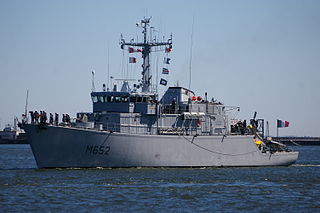
The Tripartite class is a class of minehunters developed from an agreement between the navies of Belgium, France and the Netherlands. A total of 35 ships were constructed for the three navies. The class was constructed in the 1980s–1990s in all three countries, using a mix of minehunting, electrical and propulsion systems from the three member nations. In France, where they are known as the Éridan class they are primarily used as minehunters, but have been used for minesweeping and ammunition transport in Belgium and the Netherlands, where the Tripartites are known as the Alkmaar class.

Crocus (M917) is a Tripartite-class minehunter of the Belgian Naval Component, launched on 3 September 1986 at the Mercantile-Belyard shipyard in Rupelmonde and completed on 5 February 1987. The patronage of Crocus was accepted by the city of Genk. It was the third of the Belgian Tripartite-class minehunters.
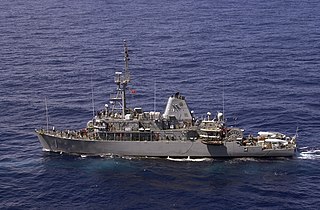
Avenger-class mine countermeasures ships are a class of 14 ships constructed for the United States Navy from 1987 to 1994, designed to clear mines from vital waterways. The ships have the hull designator MCM.
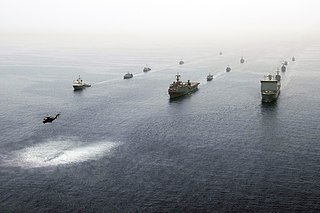
PNS Munsif (M166) is the lead ship of the Munsif-class minehunter currently in service with the Pakistan Navy.

Imanta (M-04) is the lead ship of the Tripartite class of minehunters for the Latvian Naval Forces. The vessel was formerly HNLMS Harlingen (M854), a Tripartite-class minehunter of the Royal Netherlands Navy built in 1984. Alkmaar and Imanta are, respectively, the Dutch and Latvian navies' names of the Tripartite class of minehunters, developed jointly by France, Belgium, and the Netherlands.

The Double Eagle is a remotely operated vehicle (ROV) built by the Swedish defence company Saab Underwater Systems AB and used for the disposal of naval mines.
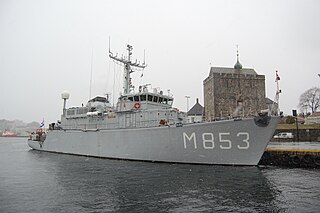
The Alkmaar class is a ship class of fifteen minehunters that were built in the Netherlands for the Royal Netherlands Navy. They are based on the design of the Tripartite class, which was developed by a collaborative effort between the Netherlands, Belgium and France, and replaced the minesweepers and minehunters of the Dokkum class.
Bellis is a genus of flowering plants in the family Asteraceae.
A low magnetic electric motor is an AC or DC motor with a reduced magnetic stray field signature.
This article represents the structure of the Belgian Armed Forces as of May 2020:

The Netherlands and Belgium are doing a joint procurement for the replacements of the Tripartite-class/Alkmaar-class minehunters. Both countries want to procure six new mine countermeasure (MCM) vessels, which makes for a total of 12 MCM ships. The new MCM ships will include a range of unmanned systems including unmanned surface, aerial and underwater vehicles alongside towed sonars and mine identification and neutralization ROVs.

HNLMS Vlissingen (M840) is the second ship in the City / Vlissingen-class of mine countermeasures vessels, and first to be built for the Royal Netherlands Navy.
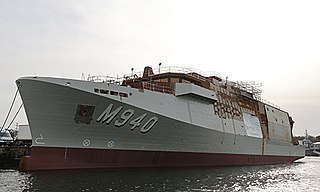
Oostende (M940) is the first ship in the City-class mine countermeasures vessels. She is being constructed in France for the Belgian Navy.















